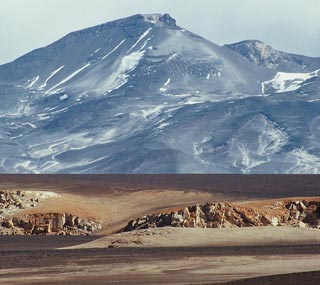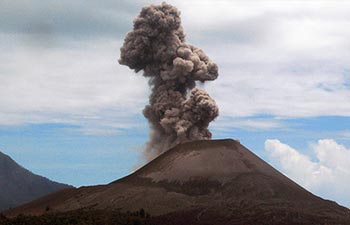Volcanoes
What is a volcano?

The Earth's crust floats on a sea of hot, molten lava. A volcano acts as a vent system that connects molten rock (magma) to the Earth's surface. The crust is weaker in some places and here the hot magma can force its way through the crust to the surface.
A volcano is active if it erupts lava, releases gas or shows seismic activity. It is dormant if it hasn't erupted for a long time but could again one day. An extinct volcano will never erupt again.
The explosiveness of a volcanic eruption depends on how easily magma can flow and the amount of gas trapped in it. Large amounts of water and carbon dioxide are dissolved in magma. They behave like gas in fizzy drinks. After opening the bottle the gas expands, forming bubbles that escape. This also happens when magma rises quickly through the crust.
There are 850 volcanoes in the world, many of them are also about 1,000 Earthquakes every year that are strong enough to be felt. The Earth's crust is divided into plates which move on the molten lava (see Continental Drift). Most Earthquakes and volcanoes occur where one plate is pushing against another. There is plate movement all around the edge of the Pacific Ocean, creating a 'ring of fire'.
Volcanoes are formed through the movement of Plate Tectonics.
The highest volcano

Ojos del Salado is the highest volcano in the world at 6,893 m (22,615 ft). It is located in the Andes, on the border of Argentina and Chile.
Due to its location near the Atacama desert, Ojos del Salado has little snow except in winter. A winter ascent is recommended because conditions are too dry otherwise. The mountain is extremely remote, and is difficult to access without renting a vehicle. The ascent is mostly a hike except for the final section to the summit which is a difficult scramble that require ropes.
The first ascent was made in 1937 by Jan Alfred Szczepanski and Justyn Wojsznis, members of Polish andinist expedition.
The deadliest eruptions

In 1883 a volcanic island in Indonesia, called Krakatoa, erupted. Over 150 villages were destroyed and the sound of the eruption could be heard in Australia, 5,000 km (3,107 miles) away.
In 1470 BC the Greek Island of Santorini erupted with five times the force of Krakotao. The power of the eruption is estimated to be 130 times greater than the biggest bomb ever detonated. The whole Island was destroyed and a massive tidal wave overwhelmed Crete. This huge wave may have wiped out all the Minoan people who lived there.
In 1815 Tambora, another volcano in Indonesia, erupted. One hundred and fifty three cubic km of rock was blown out, leaving the island 1,250 m (4,101 ft) lower than before. That is enough rock to cover the whole of England and Wales in the United Kingdom to a depth of 1 m (3 ft), or the whole of Scotland also in the UK with 2 m (6 ft) of rocks and debris.